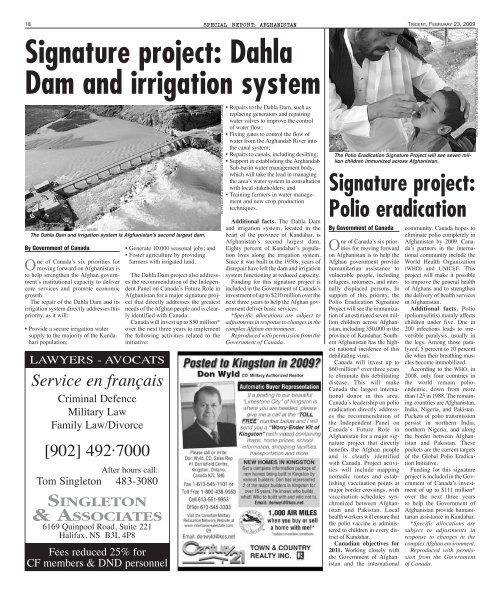February 23, 2009 - Tridentnews.ca
February 23, 2009 - Tridentnews.ca
February 23, 2009 - Tridentnews.ca
- No tags were found...
Create successful ePaper yourself
Turn your PDF publications into a flip-book with our unique Google optimized e-Paper software.
18<br />
LAWYERS - AVOCATS<br />
Service en français<br />
Criminal Defence<br />
Military Law<br />
Family Law/Divorce<br />
[902] 492·7000<br />
After hours <strong>ca</strong>ll:<br />
Tom Singleton 483-3080<br />
SINGLETON<br />
& ASSOCIATES<br />
6169 Quinpool Road, Suite 221<br />
Halifax, NS B3L 4P8<br />
Fees reduced 25% for<br />
CF members & DND personnel<br />
SPECIAL REPORT: AFGHANISTAN<br />
Signature project: Dahla<br />
Dam and irrigation system<br />
The Dahla Dam and irrigation system is Afghanistan’s second largest dam.<br />
By Government of Canada<br />
One of Canada’s six priorities for<br />
moving forward on Afghanistan is<br />
to help strengthen the Afghan government’s<br />
institutional <strong>ca</strong>pacity to deliver<br />
core services and promote economic<br />
growth.<br />
The repair of the Dahla Dam and its<br />
irrigation system directly addresses this<br />
priority, as it will:<br />
• Provide a secure irrigation water<br />
supply to the majority of the Kandahari<br />
population;<br />
• Generate 10,000 seasonal jobs; and<br />
• Foster agriculture by providing<br />
farmers with irrigated land.<br />
The Dahla Dam project also addresses<br />
the recommendation of the Independent<br />
Panel on Canada’s Future Role in<br />
Afghanistan for a major signature project<br />
that directly addresses the greatest<br />
needs of the Afghan people and is clearly<br />
identified with Canada.<br />
Canada will invest up to $50 million*<br />
over the next three years to implement<br />
the following activities related to the<br />
initiative:<br />
REPRODUCED WITH PERMISSION FROM THE GOVERNMENT OF CANADA<br />
• Repairs to the Dahla Dam, such as<br />
replacing generators and repairing<br />
water valves to improve the control<br />
of water flow;<br />
• Fixing gates to control the flow of<br />
water from the Arghandab River into<br />
the <strong>ca</strong>nal system;<br />
• Repairs to <strong>ca</strong>nals, including desilting;<br />
• Support in establishing the Arghandab<br />
Sub-basin water management body,<br />
which will take the lead in managing<br />
the area’s water system in consultation<br />
with lo<strong>ca</strong>l stakeholders; and<br />
• Training farmers in water management<br />
and new crop production<br />
techniques.<br />
Additional facts. The Dahla Dam<br />
and irrigation system, lo<strong>ca</strong>ted in the<br />
heart of the province of Kandahar, is<br />
Afghanistan’s second largest dam.<br />
Eighty percent of Kandahar’s population<br />
lives along the irrigation system.<br />
Since it was built in the 1950s, years of<br />
disrepair have left the dam and irrigation<br />
system functioning at reduced <strong>ca</strong>pacity.<br />
Funding for this signature project is<br />
included in the Government of Canada’s<br />
investment of up to $210 million over the<br />
next three years to help the Afghan government<br />
deliver basic services.<br />
*Specific allo<strong>ca</strong>tions are subject to<br />
adjustments in response to changes in the<br />
complex Afghan environment.<br />
Reproduced with permission from the<br />
Government of Canada.<br />
The Polio Eradi<strong>ca</strong>tion Signature Project will see seven million<br />
children immunized across Afghanistan.<br />
Signature project:<br />
Polio eradi<strong>ca</strong>tion<br />
By Government of Canada<br />
One of Canada’s six priorities<br />
for moving forward<br />
on Afghanistan is to help the<br />
Afghan government provide<br />
humanitarian assistance to<br />
vulnerable people, including<br />
refugees, returnees, and internally<br />
displaced persons. In<br />
support of this priority, the<br />
Polio Eradi<strong>ca</strong>tion Signature<br />
Project will see the immunization<br />
of an estimated seven million<br />
children across Afghanistan,<br />
including 350,000 in the<br />
province of Kandahar. Southern<br />
Afghanistan has the highest<br />
national incidence of this<br />
debilitating virus.<br />
Canada will invest up to<br />
$60 million* over three years<br />
to eliminate this debilitating<br />
disease. This will make<br />
Canada the largest international<br />
donor in this area.<br />
Canada’s leadership on polio<br />
eradi<strong>ca</strong>tion directly addresses<br />
the recommendation of<br />
the Independent Panel on<br />
Canada’s Future Role in<br />
Afghanistan for a major signature<br />
project that directly<br />
benefits the Afghan people<br />
and is clearly identified<br />
with Canada. Project activities<br />
will include mapping<br />
nomadic routes and establishing<br />
vaccination points at<br />
major border crossings, with<br />
vaccination schedules synchronized<br />
between Afghanistan<br />
and Pakistan. Lo<strong>ca</strong>l<br />
health workers will ensure that<br />
the polio vaccine is administered<br />
to children in every district<br />
of Kandahar.<br />
Canadian objectives for<br />
2011. Working closely with<br />
the Government of Afghanistan<br />
and the international<br />
TRIDENT, FEBRUARY <strong>23</strong>, <strong>2009</strong><br />
community, Canada hopes to<br />
eliminate polio completely in<br />
Afghanistan by <strong>2009</strong>. Canada’s<br />
partners in the international<br />
community include the<br />
World Health Organization<br />
(WHO) and UNICEF. This<br />
project will make it possible<br />
to improve the general health<br />
of Afghans and to strengthen<br />
the delivery of health services<br />
in Afghanistan.<br />
Additional facts. Polio<br />
(poliomyelitis) mainly affects<br />
children under five. One in<br />
200 infections leads to irreversible<br />
paralysis, usually in<br />
the legs. Among those paralyzed,<br />
5 percent to 10 percent<br />
die when their breathing muscles<br />
become immobilized.<br />
According to the WHO, in<br />
2008, only four countries in<br />
the world remain polioendemic,<br />
down from more<br />
than 125 in 1988. The remaining<br />
countries are Afghanistan,<br />
India, Nigeria, and Pakistan.<br />
Pockets of polio transmission<br />
persist in northern India,<br />
northern Nigeria, and along<br />
the border between Afghanistan<br />
and Pakistan. These<br />
pockets are the current targets<br />
of the Global Polio Eradi<strong>ca</strong>tion<br />
Initiative.<br />
Funding for this signature<br />
project is included in the Government<br />
of Canada’s investment<br />
of up to $111 million*<br />
over the next three years<br />
to help the Government of<br />
Afghanistan provide humanitarian<br />
assistance in Kandahar.<br />
*Specific allo<strong>ca</strong>tions are<br />
subject to adjustments in<br />
response to changes in the<br />
complex Afghan environment.<br />
Reproduced with permission<br />
from the Government<br />
of Canada.<br />
REPRODUCED WITH PERMISSION FROM THE GOVERNMENT OF CANADA
















